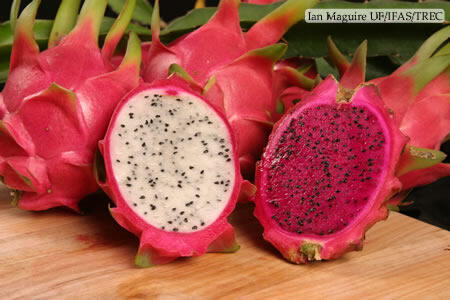These fruits are commonly known in English as “dragon fruit”, reflecting its vernacular Asian names. These include the Indonesia buah naga (lit. dragon fruit), the Khmer sror kaa neak (dragon scale), the Thai kaeo mangkon (dragon crystal), the Lao maak manggohn (Lao: ຫມາກມັງກອນ), the Vietnamese thanh long (green dragon), and the Chinese huǒ lóng guǒ (fire dragon fruit) or lóng zhū guǒ (dragon pearl fruit). Other vernacular names are “strawberry pear” or “nanettika fruit”. The name ‘pitahaya’ or ‘pitaya’ is, according to the Oxford English Dictionary, derived from the Spanish rendition of the Haitian.
Pitahaya-producing cacti of the genus Hylocereus are originally native to Mexico. They were transplanted to Central America and to other parts of the world. They are cultivated in East Asian, South Asian and Southeast Asian countries such as Cambodia, Thailand, China, Malaysia, Vietnam, Sri Lanka, the Philippines, Indonesia, and more recently Bangladesh.
The fruit was probably introduced by Europeans who brought it from the New World. In the case of Taiwan, the fruit was brought in by the Dutch. Hylocereus blooms only at night; the large white fragrant flowers of the typical cactus flower shape are among those called “moonflower” or “queen of the night”. Sweet pitahayas have a creamy pulp and a delicate aroma. It is also grown as an ornamental plant, used in gardens as a flowering vine and a house plant indoors.











